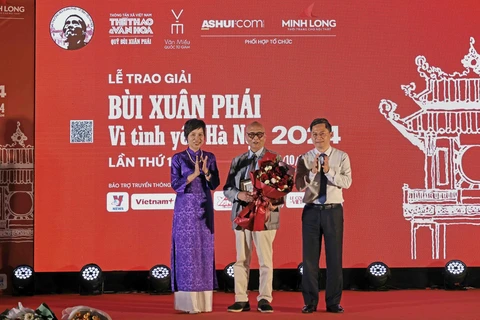
Hanoi (VNA) - Professor, Ph.D., and Architect Hoang Dao Kinh, a laureate of the prestigious Bui Xuan Phai - For the Love of Hanoi Awards, has dedicated over five decades to conserving monuments across Vietnam, with a special focus on Hanoi.
During the award ceremony on October 8, where he was honoured with the highest distinction, Kinh expressed his profound emotions. He humbly stated that he does not consider himself a "knight of architectural heritage", as many have referred to him, but rather a dedicated professional. His lifelong commitment to conserving and restoring historical monuments stems from a deep love and passion for the work.

A family tradition of loving Hanoi
Born in the capital in 1941, the architect is the son of revolutionary and cultural figure Hoang Dao Thuy. His current residence is filled with mementos from his father, particularly his writings on the old quarters of Hanoi, its residents and landscapes.
These works have provided Kinh with deep insight into the city’s culture and people, further nurturing his sense of responsibility to contribute to the preservation and promotion of the local cultural heritage – a call rooted in his family’s legacy.
A humble approach to heritage sites
Kinh has been the "chief architect" of many heritage preservation projects in the capital, including the Tay Dang communal house, the Kim Lien pagoda near the West Lake, the Van Mieu – Quoc Tu Giam (Temple of Literature complex), the Hanoi Opera House, and the Ho Chi Minh shrine in the Da Chong historical site.
One of his earliest restoration projects, the Tay Dang communal house in Ba Vi district, is the one of the city’s oldest wooden buildings dating back to the 15th or 16th century. He recalled the challenges in the late 1970s, when resources for the work were scarce and there was little formal knowledge about restoring wooden structures. The question was how to save an ancient building that had severely deteriorated over five or six centuries. If new wood was used, it would ensure the structure’s strength but compromise the historical integrity, what the architect refers to as the “cells of history”.
Through rigorous debate, a consensus was reached to adopt a guiding principle: restoration should primarily focus on preserving the longevity of the monument, maintaining its existing architectural and decorative elements without reverting the structure to an earlier historical period.
"Conservation and restoration must make historic monuments stronger and more durable, but not younger or altered in their architectural identity," he emphasised.
Kinh said he is proud that the Tay Dang restoration project helped shape key principles for preserving wooden architectural monuments, with some international experts dubbing it the "Vietnamese School of Restoration".
Soft transformation of Hanoi's cultural essence
Regarding the capital’s current heritage challenges, the dedicated architect expressed his concern about the rapid urbanisation threatening the city’s architectural treasures.
“Hanoi is developing in a large-scale and modern manner at an overwhelming pace. This is good, but it also risks overshadowing the cultural essence embedded in the city’s architectural heritage,” he remarked.
Kinh said his greatest concern is how to maintain Hanoi’s unique character amid the competition of urban expansion seen in cities across Vietnam and around the world.
It is necessary to have a "soft transformation" that bridges the capital’s past and present, blending its cultural core with the new urban areas, Kinh suggested.

For him, the transformation encompasses not only architecture but also space, landscape, and urban form. Developing Hanoi in this way requires harmonious coexistence between the established cultural, historical, and humanistic elements and modern development plans.
"To love Hanoi, one must love gently from little things, with care and respect for its fundamental values," Kinh said./.






















